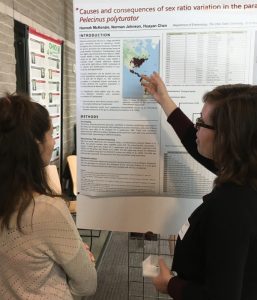Last year I chronicled my experience researching Pelecinus polyturator in Dr. Norman Johnson’s lab. This research journey included learning the biology and behavior of P. polyturator, photographing specimens, collecting in town using Malaise traps, extracting DNA and amplifying it using polymerase chain reaction (PCR), learning the importance of literature reviews, and trying to collect live adults at Zaleski State Forest. Take a look at my previous blog posts to know more about these topics and catch up on my research so far.
Over the last six months I continued working on my research, and now I have several exciting updates to share. While I took a hiatus from the lab in autumn semester to focus on my academic coursework, the research process did not stop. The DNA we extracted was sent out to be commercially sequenced. Once I returned in spring semester, it was a matter of assembling those sequences and performing phylogenetic analysis before we could start drawing conclusions.
The focus of our study was the sex ratio variation between northern and southern populations of P. polyturator. Using molecular techniques we amplified sequences of the cox1 gene, which can be used as a genetic barcode to differentiate species. Additionally, we amplified the ftsZ gene in Wolbachia, an intracellular symbiotic bacterium that can effect sex ratio in insects. We suspected that if different strains of Wolbachia were present in the different P. polyturator populations, this could be a contributor of the observed sex ratio variation.
The Wolbachia turned out to be nearly identical from every locality sampled. On the other hand, the cox1 gene varied greatly between the northern and southern populations, and even between different localities of the southern population. From this information we concluded that the Wolbachia strain was not a direct cause of the sex ratio variation. The differences in the cox1 gene, however, suggested that there may be speciation occurring between the northern and southern populations.
Doing the research and analyzing the results was only a part of the process. Science is a collaborative endeavor, and it is important for a scientist to be able to communicate the results and ideas to others in a clear and concise way.
On March 1, I had the opportunity to present my research at the CFAES Undergraduate Research Forum. This is an event where students within the CFAES (that stands for College of Food, Agriculture, and Environmental Sciences) can showcase their research to other students and faculty, as well as a panel of judges. This forum attracts a wide audience of people from many different scientific disciplines and backgrounds. It is a great opportunity to interact with people who may not be familiar with entomology or molecular genetics. At first I was nervous to talk about my research, but it ended up being surprisingly fun to answer people’s questions. I even had a female P. polyturator specimen to show visitors, courtesy of Dr. Luciana Musetti and the Triplehorn Insect Collection.
Designing and presenting the poster was a great experience for me. I quickly learned that designing a poster is much different from writing a traditional scientific paper. Both formats are separated into similar sections such as an introduction, methods, results, and conclusions. A poster, however, has space constraints and must be attractive to a general audience. Large blocks of text typical of papers are unattractive and intimidating on posters. Overall, readability is the most important trait of a good research poster. The font should be large and easy to read, and everything should be spatially organized in a logical manner.

The author and her research advisor, Dr. Norman Johnson, stand in front of the research poster at the CFAES Research Forum.
Presenting my poster at this research forum was a great preparatory experience for the upcoming Denman Undergraduate Research Forum. Because most of the research within CFAES was focused on agriculture and food science, I gained experience speaking to people unfamiliar with the topics of my research. The Denman will feature an even more diverse array of students and faculty, from business to chemistry to art, so I will need to be prepared to explain my research to those completely unfamiliar with entomology or molecular work. I will also be revising my poster using suggestions from the judges of the CFAES forum.
If you would like to learn more about my research project, as well as the research of other hardworking undergraduates, stop by the Denman in the Archie Griffin Grand Ballroom of the Ohio Union on Tuesday, April 3. I will be displaying my poster from 3:00 pm to 5:00 pm, and I would love to see you there!
About the Author: Hannah McKenzie is an undergraduate entomology major at the Ohio State University. She currently works as a curatorial assiatnt at the Triplehorn Insect Collection and is greatly enjoying her undergraduate research project on Pelecinus wasps.


